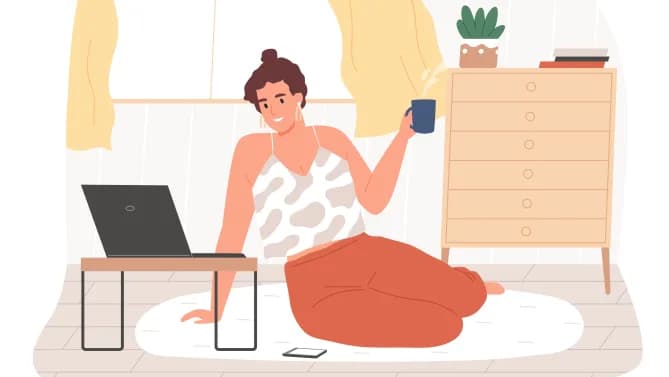The ‘First Things First’ Rule Can Make or Break WFH Success — But Only 10% of Workers Now Follow It
It took me months, but I finally did it. I joined a Zoom call in my pajamas.
To be clear, they didn’t look like pajamas. As someone who keeps a set of “at-home jumpsuits” hanging in their closet, my friends like to tease me about my definition of casual loungewear. But what’s important here is that I knew they were pajamas, and still I wore them, for the full work day.
While I don’t think I would’ve needed an official body of research to tell me I wasn’t alone here, the research nevertheless shows that I’m not alone here. What used to be a time-honored piece of WFH advice — keeping at least some degree of polish in your presentation, as if you were going into an office — has, for a lot of people at this point, completely fallen by the wayside.
A contributing editor at Inc. calls it the “First Things First” rule.
Bill Murphy, Jr., described the “First Things First” rule in Inc. as the belief that “to work from home successfully, the first thing workers needed to do was to get up in the morning, shower, and get dressed as if they were going to an office.”
Yet today, the significant majority of remote workers are no longer following this rule, according to a poll conducted by the New York Times and cited by Murphy, Jr. That poll found that “only 10 percent of people get dressed for working at home at the start of the day and change into ‘comfortable clothes’ later.”
Instead of getting dressed as though they’re going into the office, the Times indicated that most remote folks today are dressing casually, however they like, but keeping a “Zoom shirt” handy. Murphy, Jr., describes it as a “single, mildly dressy, fast-on and fast-off wardrobe upgrade for video calls.” Given what’s captured on video calls — namely, one’s upper half — there are no pants and/or shoes equivalent to the “Zoom shirt,” a fact that’s backed up by recent consumer behavior.
“Walmart reportedly sold more tops than bottoms during the first quarter of 2020, right when work-from-home was becoming a thing, and the Times says Google trends shows ‘shirts’ is at its peak in terms of search activity,” Murphy, Jr., wrote.
Comfort — in whatever small ways we can find it, including through our attire — should absolutely be prioritized. But there is a psychological toll that comes from ignoring the “First Things First” rule.
How we dress inarguably has an effect on everything from self-perception to our productivity levels. I know this as someone who once wore a power suit to work every day, for starters, but I also know it as someone who’s familiar with the following science-backed findings:
1. How you dress impacts your performance and how productive you are.
There’s a name for this phenomenon, too — “enclothed cognition,” as coined by Adam Hajo and Adam D. Galinsky, two professors at the Kellogg School of Management. (They’re the researchers behind that famous lab coat study— you know the one.)
Similarly, a study from Yale had participants partake in mock negotiations, with half of the participants wearing suits and half wearing sweats. Those in suits earned an average profit of $2.1 million, while those in sweatpants brought in $680,000.
2. How you dress impacts your mood.
In her book "Mind What You Wear: The Psychology of Fashion," Professor Karen J. Pine of the University of Hertfordshire writes: “When we put on a piece of clothing we cannot help but adopt some of the characteristics associated with it, even if we are unaware of it.” That’s one of the reasons why a lot of people find it hard to relax wearing anything other than their softest clothing. Putting on your comfiest pair of sweats, for example, sends a soothing message to your brain that’s psychologically comforting as well as physically comforting. But said ultra-comfy sweats may not be the attire that helps you perform at your best during the work day.
I’m not saying we should be wearing power suits while stuck at home during a pandemic so that we can all be better, more productive capitalists as the world continues falling apart (*insert upside-down smiley face*). Certainly, how you dress while working from home isn’t going to be the thing that makes or breaks your career. But there is a value in looking, and feeling, nice, even if that value is only felt internally by us. I think that’s incentive enough, though.
Why women love us:
- Daily articles on career topics
- Jobs at companies dedicated to hiring more women
- Advice and support from an authentic community
- Events that help you level up in your career
- Free membership, always
